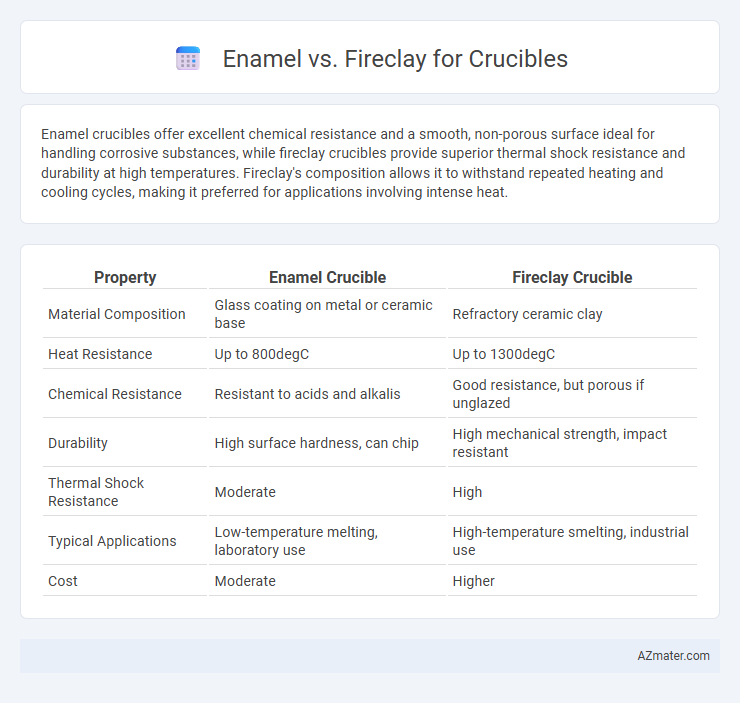Enamel crucibles offer excellent chemical resistance and a smooth, non-porous surface ideal for handling corrosive substances, while fireclay crucibles provide superior thermal shock resistance and durability at high temperatures. Fireclay's composition allows it to withstand repeated heating and cooling cycles, making it preferred for applications involving intense heat.
Table of Comparison
| Property | Enamel Crucible | Fireclay Crucible |
|---|---|---|
| Material Composition | Glass coating on metal or ceramic base | Refractory ceramic clay |
| Heat Resistance | Up to 800degC | Up to 1300degC |
| Chemical Resistance | Resistant to acids and alkalis | Good resistance, but porous if unglazed |
| Durability | High surface hardness, can chip | High mechanical strength, impact resistant |
| Thermal Shock Resistance | Moderate | High |
| Typical Applications | Low-temperature melting, laboratory use | High-temperature smelting, industrial use |
| Cost | Moderate | Higher |
Introduction to Crucible Materials
Crucibles are essential for high-temperature applications, requiring materials that withstand extreme heat and chemical reactions. Enamel-coated crucibles offer corrosion resistance and ease of cleaning, making them suitable for less aggressive melts. Fireclay crucibles provide superior thermal shock resistance and durability, ideal for repeated use in metal melting and foundry processes.
What Is Enamel Crucible?
An enamel crucible is a laboratory container coated with a smooth, durable layer of glass-like enamel, providing excellent resistance to high temperatures and chemical corrosion. This coating prevents reactions between the crucible material, often metal, and the substances being heated, ensuring purity and preventing contamination. Enamel crucibles are preferred for processes requiring quick heat distribution and resistance to acids but may chip more easily compared to fireclay alternatives.
What Is Fireclay Crucible?
Fireclay crucibles are made from natural fireclay, a refractory material known for its excellent heat resistance and durability under extreme temperatures up to 1600degC. These crucibles offer superior thermal shock resistance and chemical stability, making them ideal for melting metals and performing high-temperature laboratory experiments. Compared to enamel crucibles, fireclay crucibles provide enhanced mechanical strength and longevity, especially in applications requiring repeated heating cycles.
Durability: Enamel vs Fireclay
Fireclay crucibles offer exceptional durability due to their dense, refractory composition, resisting thermal shock and mechanical wear effectively. Enamel crucibles, while resistant to chemical corrosion and designed for medium heat applications, tend to chip and crack under extreme temperatures or sudden temperature changes. For high-temperature, heavy-duty lab work, fireclay crucibles provide superior long-term performance and structural integrity compared to enamel alternatives.
Heat Resistance Comparison
Fireclay crucibles exhibit superior heat resistance, with temperatures tolerating up to 1700degC, making them ideal for high-temperature applications like metal melting and glasswork. Enamel crucibles, typically with heat resistance up to 800-900degC, are best suited for moderate thermal processes due to their lower temperature threshold. The dense alumina and silica composition in fireclay enhances thermal shock resistance, whereas enamel coatings provide corrosion resistance but less durability under extreme heat.
Chemical Reactivity and Stability
Fireclay crucibles exhibit superior chemical stability compared to enamel, resisting aggressive chemicals like acids and alkalis without degradation. Enamel coatings, while offering corrosion resistance, may chip or crack under thermal stress, exposing the base metal to reactive substances. Fireclay's low porosity and high thermal shock resistance ensure long-term chemical inertness during high-temperature laboratory applications.
Cost and Availability
Enamel crucibles typically offer a lower cost and wider availability compared to fireclay options, making them accessible for general laboratory and industrial use. Fireclay crucibles, though more expensive, provide superior thermal shock resistance and durability, which justifies their higher price in specialized applications. Availability of fireclay crucibles may be limited due to production complexities, whereas enamel crucibles are mass-produced and readily stocked by suppliers globally.
Common Applications in Laboratories
Enamel crucibles are widely used in laboratories for heating chemicals due to their resistance to corrosion and ease of cleaning, making them ideal for general chemical reactions and sample preparation. Fireclay crucibles offer superior thermal shock resistance and high-temperature durability, commonly employed in processes involving molten metals and high-temperature ashing. Both materials are preferred in laboratory settings for their specific thermal properties but are selected based on the chemical reactivity and temperature requirements of the experiment.
Maintenance and Longevity
Enamel crucibles require careful handling to avoid chipping or cracking, and regular cleaning with non-abrasive materials ensures their longevity. Fireclay crucibles are highly durable, resistant to thermal shock, and can withstand prolonged high temperatures with minimal maintenance. The inherent toughness of fireclay allows for extended use in harsh environments, making it a preferred choice for demanding applications.
Choosing the Right Crucible: Factors to Consider
Choosing the right crucible involves evaluating material properties such as thermal shock resistance, chemical inertness, and operational temperature limits, where fireclay excels in high-temperature durability and enamel in chemical resistance. Fireclay crucibles offer excellent resistance to thermal shock and high-temperature stability, making them ideal for intense metallurgical processes, while enamel crucibles provide superior protection against corrosion and contamination from aggressive chemicals. Consider the specific application's thermal and chemical demands, the potential for thermal cycling, and the susceptibility of the material to contamination when selecting between enamel and fireclay crucibles.

Infographic: Enamel vs Fireclay for Crucible
 azmater.com
azmater.com